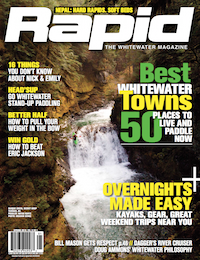The sight of some dude wearing body armour and wielding a long, single bladed paddle while standing on a modified surfboard may seem wildly out of place on a river, but it’s a scene that is becoming increasingly familiar on inland waterways across North America.
Stand Up Paddling (SUP) has been a fringe element of ocean surfing since its early days in the 1960s, when instructors and photographers used paddles to move around quickly on longboards. Over the past decade, Laird Hamilton—widely regarded as the all-time best big wave surfer—has popularized the sport by riding massive waves at legendary breaks like Jaws and Teahupo’o on a SUP board.
More recently, SUP has gained popularity with everyone from wind-skunked kiteboarders and fitness-focused hard bodies to veteran whitewater kayakers. The diversity of environments and users is giving rise to a wide variety of designs, including—in just the past couple of years—whitewater park-and-play and river running boards.
For long-time whitewater boaters like Dan Gavere, Corran Addison, Jimmy Blakeney and Jay Kincaid—some of river SUP’s leading innovators and athletes—the lure of running rivers on two feet is in the fresh challenge of learning a new skill set.
“SUP has made river running fun again,” says Addison, owner of Imagine Surfboards and Surf School in Montreal. “I reached a point where the only way to be challenged on whitewater was to be in mortal danger all the time, and that gets old. What SUP has done is make easy rivers a real challenge.”
THE FASTEST GROWING NICHE OF THE PADDLESPORTS INDUSTRY
Addison isn’t alone in his sentiments. The inaugural Whitewater Stand Up Paddling National Championships, held last May on the snowmelt-swollen Colorado River in Glenwood Springs, Colorado, attracted over 20 elite competitors from across the U.S., many of them professional kayakers or surfers. Dan Gavere, a world-class freestyle and creek boater who helped Werner Paddles develop their SUP paddle line, won the event and has been pushing the limits of whitewater SUP since he first tried it in 2006.
Gavere sees parallels between the nascent SUP boom and the early days of whitewater kayaking. “Currently we’re in the Dancer days of whitewater SUP and maybe the RPM days of surf SUP. My analogy for its potential is that SUP is to kayaking what snowboarding is skiing.”
Indeed, SUP is the fastest growing niche of the paddlesports industry. According to Werner Paddles’ sales manager, Doug Ragan, SUP paddle sales experienced triple digit growth in 2009. Board manufacturer Surftech’s marketing director, Duke Brouwer, put the number of SUP boards sold last year at well over 10,000.
“Whitewater SUP is not the bulk of the market,” Gavere allows, “but it does represent an exciting element.”
Even paddlers with modest abilities can ride a SUP board on small surfing waves too slow for most freestyle boats. Many of the river skills developed from kayaking or canoeing are transferable, but once on a wave the speed and carving advantage over a whitewater boat yields a completely different ride.
Beyond park-and-play, the downriver element of SUP is beginning to blossom as well. A handful of new 2010 models will substantially increase river running options.
If catching eddies in a Dancer seems like the dark ages, then river SUP clearly has some growing pains ahead. But with the greater weight of the surfing industry behind it, expect SUP design technology to grow at a much more accelerated rate than that of kayaking.
“It’s fun to be on the leading edge of a new, growing sport again,” Addison summarizes, “trying to see what the limits are—in skills and equipment.”




